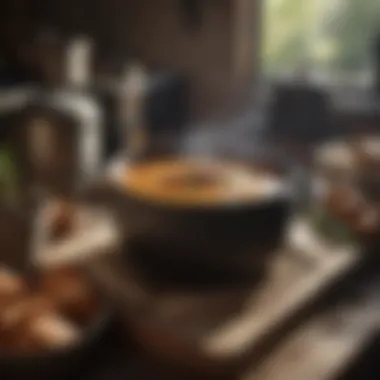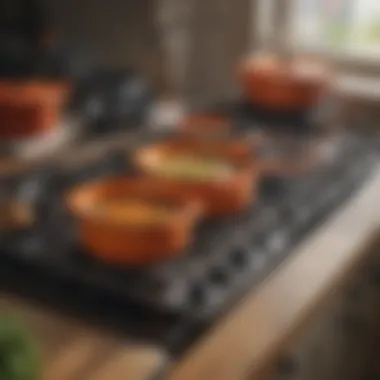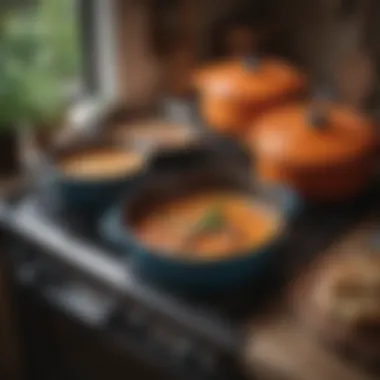Le Creuset Soup Pot vs Dutch Oven: Key Differences


Intro
In the realm of culinary cookware, understanding the distinctions and overlaps between various pots and ovens is crucial for any home chef or enthusiast. This guide focuses on two prominent offerings: Le Creuset soup pots and Dutch ovens. Both of these vessels have garnered reputations for excellence, yet their designs and functionalities cater to slightly different cooking needs. This article aims to assist readers in navigating these options effectively.
We will explore the materials used, heat distribution characteristics, maintenance requirements, and versatility of each cookware type. By the end, readers can expect to have a solid grasp on which cooking tool aligns best with their specific preferences and culinary endeavors.
Prelude
In any kitchen, understanding the tools used for cooking is essential. Two frequently debated options are Le Creuset soup pots and Dutch ovens. Each has its unique features, benefits, and intended uses. This article focuses on their complexities, allowing readers to discern which one might suit their culinary needs better.
Le Creuset soup pots are known for their impeccable design and superior heat retention. They have become a symbol of high-quality cookware. Many cooking enthusiasts appreciate the aesthetic appeal as much as the functionality.
On the other hand, Dutch ovens boast a long history and versatile applications. They can be used on the stovetop or in the oven, making them suitable for a variety of dishes from simmering to baking.
In the coming sections, we will examine pivotal aspects such as material composition, heat distribution, maintenance, and usage scenarios. By understanding these elements, cooks can select the right vessel that complements their culinary styles.
"Choosing the right pot can elevate not just the meal, but the overall cooking experience."
This comprehensive guide will provide insights for homeowners, kitchen enthusiasts, and those who love hosting gatherings. Knowing the distinctive characteristics of Le Creuset soup pots and Dutch ovens will empower you to make informed decisions, enhancing your cooking efficiency and satisfaction in the kitchen.
Understanding Le Creuset
Understanding Le Creuset is essential for anyone looking to invest in high-quality cookware. This brand has a long-standing reputation in the culinary world, particularly for its durability and aesthetic appeal. Le Creuset products are crafted to withstand the rigors of everyday cooking while providing an elegant touch to any kitchen. Familiarizing yourself with its unique attributes, from historical significance to distinctive design features, can greatly enhance your cooking experience and inform your purchasing decisions.
History of Le Creuset
Le Creuset was founded in 1925 in France, originally focusing on enameled cast iron cookware. Over the years, it has grown into a globally recognized brand. It has become symbolic of quality and craftsmanship in the culinary field. The first product was a cocotte, a round Dutch oven designed for slow cooking. This innovation set the foundation for a diverse range of cookware, which now includes various pots, pans, and bakeware.
One of the milestones in Le Creuset's history was its introduction of vibrant colors, which not only served functional purposes but also elevated the aesthetic appeal of cast iron cookware. Such colors transformed the perception of cooking from a chore into a creative and stylish endeavor. The company's commitment to quality and sustainability continues to resonate with modern consumers.
Design and Aesthetics
Color Options
The color options offered by Le Creuset play a significant role in its popularity. The brand provides an extensive palette ranging from classic hues like Flame, the iconic orange, to contemporary shades like Caribbean and Matt Black. This variety allows consumers to choose cookware that complements their kitchen's aesthetic and personal style. The unique quality of these colors is their ability to retain brilliance over time, even with regular use.
These color options not only enhance visual appeal but also serve a practical purpose. Certain shades can hide wear and tear better than others. For example, darker colors may better conceal discoloration that could result from high-heat cooking. The ability to mix and match these vibrant pieces can also inspire creativity in kitchen presentations, making cooking and serving an enjoyable experience.
Finishing Techniques
The finishing techniques used in Le Creuset cookware are equally noteworthy. Each piece undergoes a meticulous process that ensures both beauty and functionality. The enamel coating is significant here; it provides a non-reactive cooking surface that is easy to clean. This is particularly appealing to home cooks who prefer hassle-free maintenance.
Moreover, the glossy finish of Le Creuset products adds to their allure, enabling the cookware to transition well from oven to table. However, care should be taken to avoid using metal utensils, which may scratch the enamel over time. Understanding these finishing techniques is crucial for maintaining the integrity of your cookware while enjoying its aesthetic benefits.
"Le Creuset's commitment to craftsmanship ensures that each piece is not just a cooking tool but a part of family gatherings and memorable meals."
Exploring the Dutch Oven
In this article, the section on exploring the Dutch oven is essential because it provides a foundational understanding of this ubiquitous cookware. Dutch ovens are revered for their versatility, durability, and unique design features, making them a staple in many kitchens. By examining their historical context and functional attributes, readers gain insight into what makes Dutch ovens particularly effective for various cooking tasks. This knowledge enables homeowners, interior design enthusiasts, party hosts, and gardening aficionados to appreciate the benefits of incorporating a Dutch oven into their cooking repertoire.
Historical Context of Dutch Ovens
The history of Dutch ovens is quite fascinating. Originating in the 18th century, these pots were designed to hold heat effectively and distribute it evenly, making them ideal for slow-cooking and braising methods that demand precision and consistency. Traditionally, Dutch ovens were crafted from cast iron, a material that provides excellent thermal conductivity.


Interestingly, the term "Dutch oven" is believed to have originated from the Dutch's expertise in cast-iron casting techniques. Over the years, these pots have become synonymous with hearty home-cooked meals, portable cooking, and outdoor culinary experiences.
Functional Design Features
The functional design features of Dutch ovens are central to their appeal. They commonly include heavy lids that fit snugly, which helps to retain moisture and heat. This characteristic contributes significantly to the cooking process, ensuring that dishes remain tender and flavorful.
Lid Characteristics
The lid of a Dutch oven is a key characteristic that plays a vital role in its functionality. A tightly fitting lid is crucial as it traps steam and moisture, enhancing the cooking process. This feature is particularly advantageous when preparing stews or roasts, where retaining moisture is important.
Moreover, Dutch oven lids often have a slight curve, allowing moisture to circulate throughout the pot, further enriching the flavors of the dish being prepared. However, it’s essential to consider that while heavier lids provide added weight, they may also be challenging for some to lift, especially when the pot is full.
Shape and Size Variations
Another significant aspect of Dutch ovens is their shape and size variations. These pots are typically round or oval, with the round shape being more common. The shape impacts how heat is distributed and how effectively they fit onto stovetops and in ovens or on grill racks.
Dutch ovens come in various sizes, typically ranging from a few quarts to larger models capable of feeding a crowd. The size of the pot can be a crucial factor depending on the intended use—whether cooking for a family dinner or preparing a large batch for gatherings. While larger Dutch ovens may be ideal for communal cooking, they can also present challenges in terms of weight and storage when not in use.
In summary, understanding the Dutch oven’s historical context and its functional design features highlights why these cooking vessels are essential in modern kitchens. Their versatility and unique capabilities created through thoughtful design contribute significantly to their enduring popularity.
Material Composition
The choice of material in cookware significantly influences its functionality, durability, and overall cooking experience. In this section, we will explore the materials used in Le Creuset soup pots and Dutch ovens, examining how they affect heat distribution, retention, and the cooking methods best suited for each type of pot. Understanding these elements can guide consumers in making an informed choice that aligns with their culinary needs.
Enamel Coated Cast Iron
Le Creuset soup pots are primarily made from enamel coated cast iron. This material boasts excellent heat retention and even heat distribution, making it an ideal choice for cooking a variety of dishes. The enamel coating ensures that the pot is non-reactive, allowing for cooking acidic ingredients like tomatoes without altering the flavor.
This type of material is also highly durable. With proper care, a Le Creuset pot can last for generations. Additionally, the shiny, colorful exterior not only adds aesthetic appeal, but it also makes cleaning a simpler task. One notable advantage is that they are suitable for all cooking surfaces, including induction, which broadens their usability in the kitchen.
Other Material Options
While enamel coated cast iron is a hallmark of Le Creuset, various other materials are available for Dutch ovens, which might suit certain cooking styles better.
Stainless Steel
Stainless steel is known for its robustness and resistance to corrosion. This make it a favorable choice in cookware. The fundamental characteristic of stainless steel is its ability to withstand high heat without warping. In culinary terms, this means quick heating and excellent browning capabilities.
A distinct feature of stainless steel is its non-reactive nature. It performs well with acidic foods, ensuring flavors remain intact. Moreover, stainless steel is easier to maintain. It is dishwasher-safe and resistant to staining. However, it may not offer the same level of heat retention as cast iron, which is an important consideration for slow cooking or simmering.
Non-stick Surfaces
Non-stick surfaces have become increasingly popular for their ease of use and maintenance. This type of material allows for cooking with less oil, making it a healthier option. The primary advantage of non-stick cookware is its ability to prevent food from sticking, which simplifies cooking and cleaning.
However, non-stick surfaces typically do not support the same high cooking temperatures as stainless steel or cast iron. This limitation can affect the overall browning and caramelization of food. Additionally, they tend to have a shorter lifespan compared to their cast iron counterparts, as the coating can wear off over time.
Heat Distribution and Retention
Understanding heat distribution and retention is fundamental when evaluating cookware like the Le Creuset soup pot and Dutch oven. These factors significantly impact cooking efficiencies. The ability of a pot to evenly distribute heat ensures that food is cooked uniformly, while retention refers to how well the pot maintains heat over time. This is especially important for recipes that require long cooking times, such as braises and stews.
Benefits of Optimal Heat Distribution
An even heat distribution prevents hotspots, which can lead to uneven cooking and potential burning. For instance, when making a delicate sauce, the heat should envelop the pan's surface to avoid scorching. Le Creuset’s enameled cast iron is designed to achieve this even heating, making it reliable for various cooking techniques.


Considerations for Heat Retention
Moreover, heat retention affects not only the cooking process but also how dishes are served. Good heat retention means food stays warm, enhancing the dining experience. A Dutch oven is often preferred for slow cooking precisely for this reason, as it retains heat well during lengthy periods on low heat, making it ideal for hearty meals.
Key Elements to Consider
- Material: The composition of the pot greatly influences thermal conductivity. Enamel-coated cast iron materials of Le Creuset excel at holding and distributing heat.
- Thickness: The thickness of the pot’s walls contributes to its ability to retain heat. A thicker wall generally means better retention.
- Lid Design: The fit and weight of the lid can affect moisture retention and cooking efficiency. Well-fitted lids create a sealed environment for optimal results.
It is essential to choose the pot that aligns with your cooking style and the specific dishes you enjoy preparing.
By understanding these attributes, home cooks can select the right cookware for their kitchen needs, enhancing overall culinary success.
Versatility in Cooking
When evaluating cookware options, versatility remains a crucial factor. The ability to utilize a single piece of equipment for various methods of cooking adds significant value. Le Creuset soup pots and Dutch ovens, both versatile, serve multiple cooking applications, making them essential for any culinary enthusiast. Understanding how each pot functions across different cooking methods can help homeowners, party hosts, and cooking aficionados. In practical terms, versatility means you can prepare a broader range of meals with the same tools, optimizing time and storage in the kitchen.
Method Applications for Le Creuset
Soups and Stews
Le Creuset soup pots shine when it comes to soups and stews. The specific aspect of even heat distribution in these pots is ideal for simmering and flavor development. Soups and stews require a steady, gentle heat to allow flavors to meld effectively, and Le Creuset’s material composition enables this.
One key characteristic of utilizing a Le Creuset soup pot for this purpose is the depth and narrow shape, which helps retain moisture while promoting rich flavors. This method is popular because it allows for one-pot cooking, simplifying the process and cleanup.
The unique feature of these pots is their enamel coating, which prevents food from sticking and makes cleaning easy. However, care should be taken not to use metal utensils to avoid scratches, but for the most part, they are highly durable.
Baking
Baking in a Le Creuset is another method where its versatility is evident. When it comes to baking, these pots can withstand the high temperatures needed for recipes such as bread and casseroles. The heat retention capabilities allow for thorough cooking and browning.
The primary advantage of using a Le Creuset soup pot for baking is the ability to create a visually appealing presentation straight from the oven to the table. Their design lends itself well to serving as an attractive centerpiece. However, while they perform well for dishes like sourdough or lasagna, they might not be the traditional choice for certain baked goods, such as cakes, which could benefit from different bakeware.
Dutch Oven Culinary Uses
Braising
The Dutch oven is well renowned for its superior braising capabilities. The method of braising involves cooking meat slowly at a low temperature, which helps break down tough fibers and infuse flavor. This cooking style typically requires the environment to retain moisture, something a Dutch oven excels at, thanks to its heavy, tight-fitting lid.
Braising is a beneficial choice because it produces tender, flavorful dishes. The unique feature is its versatility to go from stovetop to oven without needing to transfer to different cookware. However, it can be heavy when full, which might be a consideration for some home cooks.
Slow Cooking
Slow cooking is another area where the Dutch oven shines. This method allows flavors to develop deeply over extended periods, making it ideal for many dishes, including hearty stews and roasts. Dutch ovens, designed to trap heat and moisture, facilitate this cooking process remarkably well.
The key characteristic of slow cooking is its emphasis on low, consistent heat, which Dutch ovens provide effortlessly. This method is popular among busy homeowners as it can be set up in the morning and left to cook throughout the day. An advantage here is that this cook method often enhances the palate experience. However, one must ensure there's enough liquid included to maintain moisture, as it can sometimes evaporate, leading to dry results.
Maintenance and Care
Maintenance and care play crucial roles in ensuring the longevity and optimal performance of cookware. In the case of Le Creuset soup pots and Dutch ovens, proper maintenance can significantly affect their appearance and functionality. These items are not merely tools; they are investments that enhance culinary experiences. By dedicating time to care for them, users can preserve their aesthetic appeal and cooking efficiency.
Cleaning Le Creuset
Le Creuset soup pots require careful cleaning to maintain their vibrant colors and enamel finish. Typically, these pots are dishwasher-safe, but handwashing is recommended for best results. Use a soft sponge and mild soap to avoid damaging the surface. Avoid abrasive tools such as steel wool, as they can scratch and dull the enamel.


- Rinse the pot thoroughly after washing to eliminate any soap residue.
- For stubborn stains or baked-on food, soak the pot in warm soapy water before cleaning.
- To restore shine, a mixture of baking soda and water can be used as a gentle scrubbing paste.
It's essential to dry the pot completely after washing to prevent moisture accumulation, which can lead to rust at the base of the pot.
Caring for a Dutch Oven
Caring for a Dutch oven also requires specific attention to its material. Many Dutch ovens are made from cast iron, which necessitates a routine of seasoning to maintain its non-stick properties and to prevent rusting.
- After each use, clean the pot with hot water and a soft brush or sponge. Avoid using soap unless absolutely necessary, as this can strip the seasoning.
- Dry the pot immediately and completely to avoid moisture.
- Apply a thin layer of vegetable oil or shortening while the pot is still warm. This helps to condition the surface.
If the Dutch oven is enameled, the care instructions are similar to those for Le Creuset. Ensure that you avoid drastic temperature changes to prevent cracking and be cautious while using metal utensils, which can scratch the enamel.
Proper maintenance of Le Creuset and Dutch ovens not only extends their lifespan but also enhances cooking performance, ensuring you enjoy the full benefits of these versatile kitchen essentials.
Price Considerations
Understanding the pricing dynamics of Le Creuset soup pots and Dutch ovens is crucial when making a selection. This section reveals factors that can influence prices, such as materials, craftsmanship, and overall brand prestige. The cost can heavily impact purchasing decisions, especially for homeowners and culinary enthusiasts balancing quality with budget.
Cookware can range widely in price based on several specific elements:
- Material Quality: High-quality materials like enamel-coated cast iron significantly raise the price compared to alternatives.
- Brand Reputation: Le Creuset is seen as an icon in cookware, which reflects in its premium pricing due to brand heritage and trust.
- Design and Aesthetics: Unique designs and vibrant color options often drive up costs.
- Functionality and Versatility: Cookware that offers multi-use capabilities tends to be pricier but can provide better value over time.
Before investing in these kitchen essentials, consumers should consider both immediate and long-term cost implications.
Cost of Le Creuset Products
When looking at the cost of Le Creuset products, one can expect to pay a premium price. This aligns with their reputation as leaders in quality cookware. The cost of a Le Creuset soup pot can start from around $200 and may exceed $400 for larger sizes or specialty colors. Factors influencing the price include:
- Size: Larger pots naturally come with higher price tags.
- Special Editions: Limited editions or unique color releases can command even higher prices.
- Retailer Pricing: Prices can vary by retailer, with sales occasionally offering lower rates.
Investing in a Le Creuset item is often viewed as a long-term decision, as these products are known for their durability and performance.
Price Range of Dutch Ovens
The price of Dutch ovens varies significantly depending on brand, size, and material. Generally, you can find Dutch ovens as low as $50 for basic stainless steel models and around $100 to $300 for good quality cast iron options. Premium brands, like Staub or Lodge, can elevate prices in the range of $200 to $400.
Some factors to keep in mind when evaluating Dutch oven prices include:
- Material Composition: Cast iron and enamel-coated options will typically cost more.
- Brand Analysis: Each brand carries different values; for instance, All-Clad and Cuisinart provide reliability at various price points.
- Sales and Events: Yearly sales events, like Black Friday, can lead to significant discounts, making higher-quality Dutch ovens accessible.
Being aware of the price considerations can help buyers make an informed decision regarding both Le Creuset soup pots and Dutch ovens. Careful evaluation of features, pricing, and usability ensures that the right choice aligns with culinary aspirations.
Epilogue
In this comprehensive comparison between Le Creuset soup pots and Dutch ovens, it is essential to synthesize the key aspects that have been discussed. The significance of knowing these differences cannot be understated, especially for those who value their cooking experiences and aim for optimal results in their kitchen endeavors.
Summary of Key Points
- Material Composition: Both Le Creuset and traditional Dutch ovens primarily use enamel-coated cast iron, but each brand may vary in quality and thickness, impacting durability and heat retention.
- Heat Distribution: The distribution of heat is crucial in cooking. Le Creuset soup pots tend to heat quickly, while Dutch ovens provide steady, even cooking across all surfaces.
- Versatility: Le Creuset soup pots excel in making soups and stews, while Dutch ovens are preferred for braising and slow-cooking methods. Each cookware serves unique culinary purposes.
- Maintenance: Cleaning methods differ slightly. Le Creuset offers a smoother surface that is generally easier to clean, while Dutch ovens may require more attention depending on their coating.
- Cost and Care: Le Creuset products typically carry a premium price tag, but many users find the investment worth it, considering the longevity and performance of the cookware. Dutch ovens are available in various price ranges, offering options for different budgets.
"Understanding the intricacies of each cooking vessel can elevate your culinary skills and enhance your kitchen experience."
Final Recommendations
When choosing between a Le Creuset soup pot and a Dutch oven, consider the following:
- Cooking Style: If you frequently make soups and want to showcase your cookware, Le Creuset might be the more visually appealing option. On the other hand, if your focus is on hearty meals and versatility, a Dutch oven can be invaluable.
- Budget: Evaluate your finances. Le Creuset is a notable investment, while Dutch ovens offer affordable alternatives without sacrificing quality.
- Long-term Use: Think about how often you will use the pot. If you cook daily, the longevity of Le Creuset might justify the cost.
- Aesthetics: Personal preference in design can influence your choice significantly. Generally, Le Creuset offers a broader range of colors and finishes.
In summary, both cookware options have their strengths and potential drawbacks. Assess your culinary needs against the features of each to foster an informed decision.















